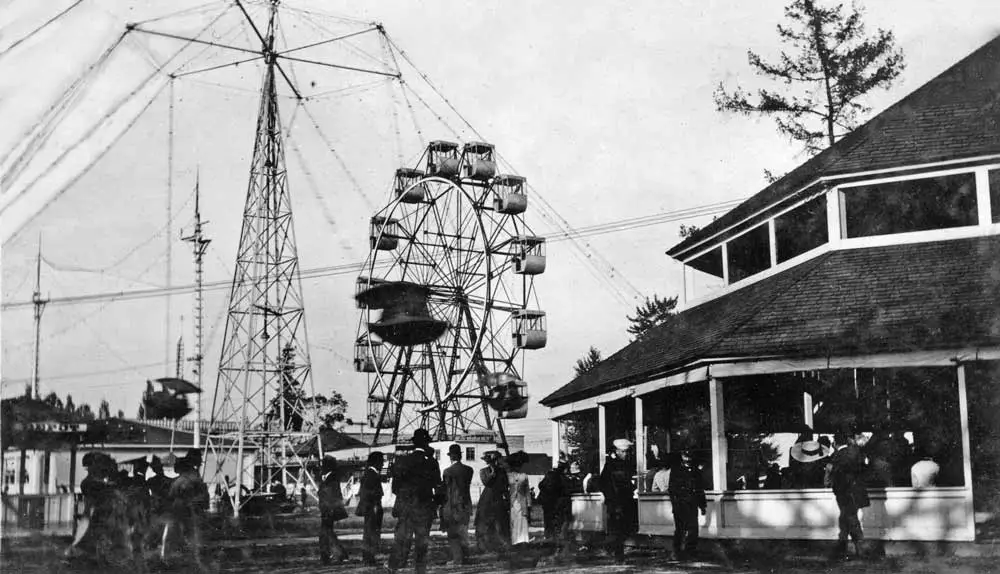
When Abraham Lincoln became president of the United States he appointed his friend John J. McGilvra U.S. Attorney for Washington Territory. Soon after his arrival in Puget Sound, McGilvra purchased 320 acres on the western shore of Lake Washington.
To reach his claim from Puget Sound, McGilvra cut a straight path from downtown Seattle to the lake – probably an ancient Native American route. At first this rugged path was a horse trail, then became a stage coach way, later a rattling trolley system featuring cars with removable glass panels, advertising boards, and a friendly motorman. The popular cars ran every 2-3 minutes.
Historian Nard Jones in his 1972 book Seattle describes riding to the park “with gripman’s greasy gloves tight and busy muscles bulging and the brake ready at hand. This was the breathless part of the journey, with the little car swaying on the high wooden trestle (the Arboretum link) and a veritable forest on either side . . . Then finally the sight of the big lake, and a level stretch to a wooden building with vertical shutters propped open for the sale of ice cream cones and soda pop.”

McGilvra and his family established a lakeside farm called “Laurel Shade.” Within a year, and after observing the burgeoning summer popularity of his neighborhood, he offered nearby lots for sale. However, there was a hitch: he stipulated that only “cottages,” i.e. summer residences, could be built on the small lots. Next, he set aside 21 acres for public use and he named it “Madison Park” for our fourth U.S. President.
The 1890 Seattle City Directory listed “Madison St. Pavilion, Geo. K. Beede, Propr.” During that period (1892-1900) a baseball park and wooden grandstand were built just north of Madison Park near the lake. By 1898, George Cotterill’s 25-mile city-wide bicycle paths included Madison Park.
The burgeoning waterfront development included a boathouse, piers, a wooden promenade and twin bandstands offshore with shoreline seating. Beer was sold to audiences while they listened to Wagner’s Band play Gilbert and Sullivan operettas.
In 1902-1903, the famous Massachusetts-based Olmsted Brothers landscape company was hired to develop a Seattle system of parks and boulevards. The Olmsted firm opted to by-pass Madison Park as part of its proposed city-wide parks and boulevards, probably because of the area’s Tivoli amusement park atmosphere – not considered conducive to real estate sales for a settled, quiet neighborhood.
The park in those days was described by H.A. Chadwick, owner and editor of the Argus, as “a Coney Island,. . . a playground for the industrials, a breathing spot for the Employed . . . The show is one inharmonious medley of sounds, and therein lies the charm of the resort for the people who go there.”
A 500-seat pavilion was a Madison Park centerpiece, surrounded by formal gardens and courtship walkways among the trees. A racetrack was built for harness and regular racing near today’s nearby exclusive Broadmoor district. Boats offered local cruises aboard Captain John Anderson’s Steamboat Company, whose main route connected Madison Park to the city of Kirkland on the eastern shore. This commercial water travel was referred to as the “Mosquito Fleet.”
In 1917 an amazing and unexpected event occurred. Following the opening of the ship canal connecting Lakes Union and Washington, the lake’s water level dropped 9 feet, creating an expanded shoreline. That new land, including bathhouse and beach, was transferred to the Seattle Park Department (private property exempted).
After the last ferry steamed away in the 1940s, and the “floating” bridges were built, Madison Park grew into a quiet urban village. All traces of its birth as a Coney Island have now disappeared.
Discover more from Post Alley
Subscribe to get the latest posts sent to your email.

What a story! Thanks for telling it.
Great story! My neighbor’s father was a streetcar conductor on the Madison line and he had stories about ladies with gaudy feathered hats causing problems…